#Historical context
Explore tagged Tumblr posts
Text


Harry Truman interviewed in 1961.
511 notes
·
View notes
Text
The Origin of Vampire Rules

Something I always find very funny in vampire media is, that vampires usually have those certain rules, right? Vampires usually cannot go out into the sun. Often they will not be able to touch crosses or even be paralyzed by just looking at a cross. They might be shapeshifters. Vampires often cannot cross flowing water, and they also cannot cross a home without an invitation. Sometimes they are weirdly allergic against garlic. Also sometimes they have no mirror reflection. Or even not a shadow. They might not be able to cross onto sacred land (so for example they cannot set food on church ground). And of course they need to drink an undefined amount of blood.
And yes, this is just another excuse to talk about some more mythology - and how stuff happened to end up culture the way it did.
Origins of the Vampire Myths
Chances are, that someone told you that vampires are literally everywhere in the world and one of those myths that somehow is everywhere around.
This is not true - and mostly goes back to people applying "vampire" to pretty much everything that is arguably undead. Even though most of those figures technically are arguably a lot closer to zombies. If it does not leech energy or blood from living people, it is not a vampire.
So, actually vampires were a very specific thing that originated specifically in Eastern Europe. We are fairly certain that the origin of the myth came actually from some Ancient Greek myth that spread out into those places and then shifted. But the vampire itself comes from Slavic Myths. In those we have a variety of beings, that would qualify as vampires. Strigoi, Upir, Lugat, Moroi and quite a lot of others. There was a lot of overlap between those creatures and "evil witches" in a lot of times, and not all of them actually drank blood, but they drained at least your energy in some way.
Among people studying folklore folks are fairly certain that the myths came originally from people not fully understanding certain sicknesses. So basically, when a village was struck by a sickness like that, people would go: "Oh, this has to have been Alfred coming back from the dead," because Alfred recently died and it was the best explanation they came up with. And because people did not understand how dead bodies worked, they also would then see stuff like the hair and nails appearing longer when they opened the grave, which they saw as a proof that the dead was not really dead.
Generally speaking, there were then a couple of things that would be done to prevent them from coming back. Some people would just behead the dead body, others drove a stake through the heart of the people, while others might just tie up the legs of the dead.
But yeah, the one thing is that vampires come mainly from Slavic cultures. This is the important bit about vampires you need to remember. Because a lot of this comes back to this.
The Vampire Rules
The Vampire Rules are really fun, because they come together from three very different sources: From the fact that they were Slavic, from English folklore, and then from limitations in media.
So, let me go through typical vampire rules.
Vampires shapeshift: Vampires being shapeshifters goes back to Slavic mythology. In those vampires, witches and shapeshifters often were just the same kind of thing and had a lot of overlap.
Vampires cannot cross water: This originated probably in the Rennaissance. And it mainly originated from the fact that the people noticed that vampires only seemed to exist in Eastern Europe. Which people started to find weird. So, they had to come up with an explanation. And that explanation was: For some reason the vampires could not cross the Danube. This over time merged into "vampires cannot cross water".
Vampires are allergic against garlic: This is definitely something that goes back to the original myths. It is believed that this might be connected to the fact that garlic has an antibiotic effect. And as I said, vampire myths probably originated with unexplained sicknesses. So it is not hard to believe that people who ate garlic might not have gotten (as) sick, so folks were like: "Oh, the garlic kept the vampire away."
The stake through the heart kills vampires: This myth also comes from the vampire practices back then. On e way of burying a vampire in a way that it would not come back was to put a stake through the dead body.
The cross, not entering homes, and holy ground: Ironically, all those things that are probably connected to the same thing. Because these weaknesses are usually connected to more English folklore. While people definitely have hidden in churches (partly because of the law of sanctuary) forever, there is some good evidence that this actually comes more from British fairy culture - that then got applied to all other forms of paranormal creatures. And we know that around the 18th century, there was a whole big vampire scare in England, that definitely mixed a lot of Eastern European vampire lore with the lore of the Otherworld and Fae from Celtic mythology. Vampires having glamour of sorts probably is also connected to this.
Vampires do not have a reflection: This specifically is dated back to Bram Stoker, meaning everyone else after this just used this from Bram Stoker. The theory is that Stoker's idea was that mirrors somehow reflect the soul - something like that.
The Baptism of Blood: Another vampire thing that goes back to Stoker specifically is vampires having to exchange blood with someone to make them a vampire. Aka, drinking thier victims blood and then giving blood to them. In fact, in Stoker's work it was implied to have to happen three times until someone is turned a vampire. Which at least makes sure there are no accidental vampires.
Vampires drinking blood: Ironically the specific thing of vampires drinking blood also comes from Victorian Gothic literature. While this was not fully unheard off in mythology, it was not such a common trait there. But in Victorian literature it became THE vampire calling card. And this for two reasons. Reason 1: Welp, blood drinking is a neat symbolism for sex at time where you were not allowed to write about sex. Reason 2: ... Anti-Semitism and blood libel. I am sorry I could talk around this, but yeah, we definitely are certain that some of the Victorian vampires drink blood because the folks writing were implying blood libel. Welp.
Why Vampires Burn in the Sunlight: The dumbest bit of vampire lore I know is why vampires burn in sunlight. No, this does not originate with mythology - neither Slavic, nor Celtic. No, this does not go back to Dracula or another book of the time. Vampires in Victorian literature were fine and dandy in the sun. They might not be able to use certain magics, but other than that they were fine. No, the reason vampires burn in sunlight is... that the original Nosfertu ran out of budget, and needed a convenient way to dispatch the vampire. So they decided: "Oh, actually he burns in sunlight." And then, that stuck.
#castlevania#castlevania netflix#castlevania nocturne#dracula#dracula daily#vampires#vampire mythology#interview with the vampire#carmilla#gothic fiction#horror fiction#vampire novels#history#historical context#slavic mythology
202 notes
·
View notes
Text
I hadn't the heart to write last night; that terrible record of Jonathan's upset me so. Poor dear! How he must have suffered, whether it be true or only imagination. I wonder if there is any truth in it at all.
Mina writes this as a response after reading Jonathan's journal all by herself, without any outside influence, and oh how beautifully merciful it is.
This book, this novel came out in 1897 right in the middle of queen Victoria's diamond jubilee in england. The first successful self driving taxis go through the streets, the public has noticed the national decline as urban poverty had rised more, and the Lunacy act has been introduced just seven years ago (1890) in which the only people who could ever have access to victorian england's psychiatric treatment were the certified as "mentally insane", which then were admitted to an asylum* shortly after.
(*different rules for different socioeconomical classes apply.)
Of course this being victorian england meant that stigma, and prejudice ran rampant after the poor people subjected to these treatments in order to place them outside of what was deemed polite society. Moreso when the actual label given to you once you were admitted was "pauper lunatic", or whatever your doctor decided for you if you were wealthy enough to escape the label. In all of this social climate, this stigma, this prejudice, here comes Mina, recently married woman to Jonathan who comes from a harrowing experience marked by a brain fever coming all the way from Transylvania.
It was not recommended to marry men like Jonathan because of his illness, and Mina did it anyway. The mere concept of ptsd (and everything that comes with it) is only applied to soldiers who are thrown into the psychiatric system by their families, yet Mina guided and cared for Jonathan after he had a panic attack without caring who might see. Jonathan wrote about the most horrifying events that a young person could see done by a supernatural monster, and Mina (despite being on the fence about the truth of the journal) expresses empathy for his suffering.
For Mina, it doesn't matter if what is written on the journal is real or the terrified ramblings of her traumatized husband, she knows that what matters is that Jonathan suffered greatly, and that she has to help him. Even if Mina debated to herself about the possibilities of everything, she decides that she can't just do nothing with all of this information, she can't simply ignore, so Mina wipes out the typewriter... Just in case.
#This is the best response to the horrors without dismissing them which makes Mina the best woman ever#dracula daily#dracula#mina harker#mina murray#jonathan harker#jonmina#historical context
368 notes
·
View notes
Text
Thoughts on : Jonsa as a political match
I would love to hear other people’s thoughts on this by the way, it’s all just fun escapism from real life for me!!
I was thinking the other day about how ridiculous it is that in the final season of game of thrones, a Jon and Sansa match was NEVER presented, by anyone. In any other actual historical scenario, this would be almost instantly an idea in many advisors minds.
The whole point for them is to keep the North safe, which can only really be done with a northern and southern alliance. Obviously, with how it ended, Daenerys wouldn’t have been happy with this ending personally. Logically though, if she believed Jon to be on her side and her ally, it would be perfect for her.
If she can’t have children, she needs heirs, or it’s all for nothing. Those heirs would ideally be of her blood. Again, without that there is no new dynasty or restoration of her house. It begins and ends with her, which never feels like her goal or ideal outcome.
The North would have little choice but to support her rule, if northern children were being brought up in Kings Landing to one day succeed her. They would be the mix of the north and south so desperately needed to secure Westeros.
For people who are bothered by the cousin thing, you probably aren’t into history, because if you were, you’d know this was the norm for most of human history. Gross to us now (obviously), but a relatively new taboo. Incest, until recently, was really only frowned upon or forbidden between the closest of blood relatives. So nephews/ nieces with Aunts/ uncles, parents with their children, and siblings.
Cousins, on the other hand, were a great way to keep wealth and power in the same hands. For the common people, it was more a lack of options, a familiarity brought by isolation and less movement. Most people lived and died pretty close to where they were born (for the most part), and those villages and towns were often made up of a variety of cousins, through years of staying put.
Knowledge of the consequences on offspring of familial relations, was not in the mainstream mind until the early 20th century, and even still, royals continued to practice cousin marriages.
To look at this show or book series through a current day lens is boring and not of the asoiaf world. So looking from a historical lens, at the time this is set, almost all marriages in prominent houses, had either grandparents or great grandparents in common, for the reasons above.
In what world would political advisors to kings and queens, with all their motives of money and power and land, be squeamish or cower to the impropriety of it. To them this would be like winning the lottery. The power stays in the north’s hands, and appeases the new Queen. I think they would be clawing to immediately propose a match between them, honestly.
Their children would be the end of the divide within the realm, a new hope and peace. They were not close as children, and even if they were, again, realistically the people advising wouldn’t give a fuck. So many historical brides were dragged down the aisle in tears begging their father to save them from their fate.
In a match between Jon and Sansa, while uncomfortable at first, eventually would become the norm. She would not have to be afraid of what man she has to suffer next, because she knows and trusts Jon, which accounts for much more than some viewers seem to think.
In a real life historical scenario, I think she would agree to the match quickly, or even plant seeds to suggest it herself. He, of course, would be reluctant but would see an opportunity to protect her, and in turn her other siblings.
In history, warrior kings don’t become kings by playing it safe, and shying away from what needs to be done to secure their line.
For me, this is actually the most frustrating thing in the final season of game of thrones. To not acknowledge the truth of Jon’s lineage, and the way it significantly shifts the chess board, feels like a mistake in a more historical context.
For a show that is all about incest in some moments, they seem to have been too squeamish to embrace the one time it would actually be acceptable, and make logical sense.
Maybe the books (the never ever published books most likely) will do a better job of fleshing this out, especially when the parallels to Ned and Cat seem so glaringly obvious. The people around them, and Sansa herself, (Jon to a lesser degree) have been bred to see these opportunities and harness them to their houses advantage.
To me, it’s the only pair that makes any sense, if trying to preserve the historicity of it.
Without this match even being SUGGESTED, by Davos or the free folk or another of the northern lords, this whole “Aegon Targaryen” plot point is, well, pointless.
*One more thought. I understand the ick factor for some people. However, historical accuracy would demand this or a similar match for any king or queen. Think Habsburg’s, Plantagenet’s, and even the current Windsor’s.
Maybe I’ve spent too long reading about history and I’m just de-sensitized to it, but forgive me for finding the idea of Jon and Sansa a reasonable choice, in a show where Theon fingers his (actual) sister, and main characters in early seasons are the product of brother-sister incest.
🤷🏼♀️
Would they really be so terrible?!
They are cowards for never once addressing this clear path, historically taken thousands of times.
** last last thought. They did have a chemistry/tension, and I doubt it would have been hard for either character to fall into a comfortable routine of being married to the other.

#book jonsa#asoiaf#game of thrones#aegon targaryen#house stark#jon snow#jon x sansa#jonsa#sansa stark#got#gotedit#controversial take#rambles#ramblings#thoughts#historical context#historicity in media#historical accuracy#i don’t know#asoiaf discussion#house of the dragon#political marriage
109 notes
·
View notes
Note
Was it regular or at least seen as normal for the 29-year-old to propose to a 19 year old? If so until when was this common in England or British Isles I suppose?
The short answer is yes, completely normal, and it was normal until about the 80s. You can get a sense from this chart, which shows median age at first marriage in England and Wales:
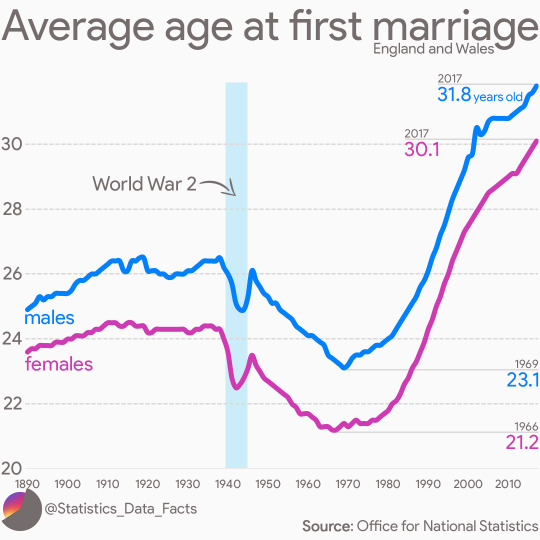
(from this blog, which also shows the same stats for the USA, where people have generally married a little younger and with a slightly larger age gap.)
Now I'm going to do a long answer under the cut because I find this subject fascinating. It ties into all kinds of questions, like who counts as an adult and what is marriage even for, where our answers have changed a lot and are still at least somewhat in flux.
In the 1890s, marriage was - in short - for starting a family. I mean, it was a lot more complicated than that, but this is a tumblr post not a book, so let's go with that. Couples in England did practise some element of family planning, which you can tell because the average fertility rate started falling from 1880 onwards (and I find it fascinating that this predates reliable contraception), but generally speaking it was a social expectation that women would not have sex outside of marriage, and if they did, they would get married on learning that they were pregnant.
The assumption that marriage = children was what informed acceptable ages for women to get married. Legally, boys could get married at 14 and girls at 12 provided that they had their parents' permission, but they very rarely did. It was widely recognised that early pregnancy was dangerous to girls' health - usually expressed as concern for their ability to bear children. That's where it was even possible, given that on average girls in the 1890s only started their periods at 17.
For example, the Lancet in 1883 published this about the ideal age for women to marry:
Prevention [of illness] is to be, in part, effected by avoidance of unions of immature women or of elderly women: in other words by securing that women are married at the age of nubility, or best age of marriage, with a view to fertility and the rearing of healthy children, and the safety of the mothers and this age is fairly well ascertained to be, for a population or mass of women, not under twenty and not above twenty five.
Obviously there were all sorts of other cultural pressures at play. A woman in Lucy's class, who would be expected not to work, was a cost to her family that they would ideally like to transfer to her husband. And a lot of the literature from this time assumes that young women will want to get married quickly; concerns about early marriage are often phrased around discouraging young women from being hasty, rather than the fear that their family will put them under pressure. Immaturity is raised as a concern, particularly from the perspective that young women might make unwise choices.
On the man's side of things, the important thing was being able to support a family. This was a little bit more complicated than we might imagine because a) some married women worked (about 40% of women were employed in the 1890s in Britain, about twice the rate of the USA), b) the work of wives in the household helped to save money, and c) after the age of 11 the kids could legally work too.
But generally speaking getting married was an expense that men needed to be able to afford, and more so the higher the class of the couple (because then both the wife and the children would be less likely to work).
That pushed men's first age at marriage older, and particularly so in higher classes where the expenses were greater. You can see that in this table from 1890:
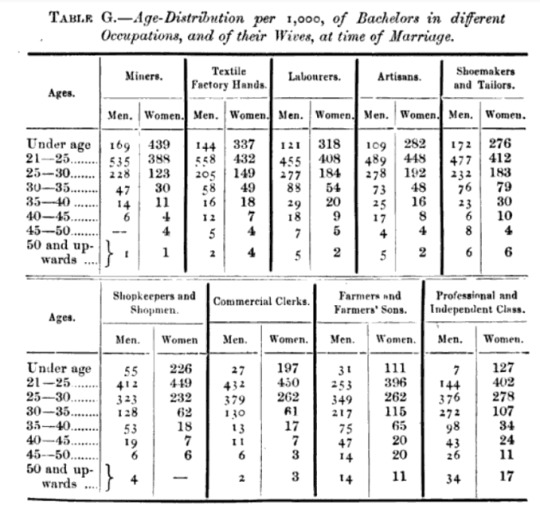
Every main character is in that final "professional and independent class" section, and we can see that the suitors are very typical in wanting to marry in their late 20s, whereas Lucy is a little more unusual, though not unheard of, in being under 21.
It's also interesting that first marriage is clustered in a relatively narrow age band. Most people had married by the time they were 35, though again there are slightly more older bachelors in the middle and upper classes. It's from the late 19th century that the "half your age plus seven" rule for age gaps starts to appear - sometimes as an ideal age gap, but sometimes used in the same way as today, where relationships with a greater age gap are described as inappropriate. And we can see from the stats that actually, the average age gap has barely changed.
I think it's really the same set of considerations that made first marriage so young in the 1960s. The economy was doing well, so men were able to support a family earlier in life, but the pressure to get married in order to have sex and start a family remained. And young women were generally in much better health than their 1890s predecessors so could have children at a younger age more safely.
OK, so what changed in the 1970s that meant that age at first marriage started going up? One thing is that having children out of wedlock became more normal so there was gradually less need for a hurried wedding if you found out you or your partner was pregnant:
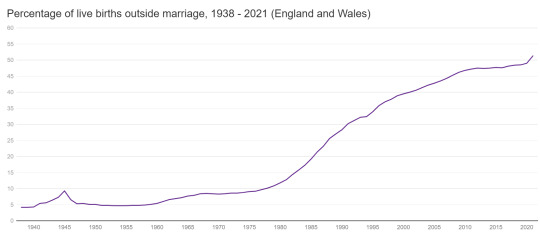
Reliable contraception (the pill was licensed for unmarried women in 1967) and access to abortion (decriminalised in England and Wales in 1967) also made it safer to have sex outside of marriage without the risk of pregnancy - so less need to get married in order to have sex.
Though the ultimate decoupling of sex and marriage in England and Wales only happened in 2023, when the age for legal marriage was raised to 18 (it had been 16 with parental consent) while the age of consent to sex remains at 16. The change happened quite quietly and the government was a bit embarrassed that they had allowed child marriage until then, but in some ways it was a significant step to say that actually, legally, sex can happen without marriage being an option.
Women's ability to work and to live independently is also a significant factor. Here's the female employment rate over time:

I would also expect the line to be a bit steeper if the ages covered were, say, 21 to 60 instead of 16 to 64, given a) the growing number of women in education from 16 to 21 who might not be working and b) comfortably-off professional women taking early retirement.
I can't find stats over the whole century for women's labour participation, but the milestone legislation of the Equal Pay Act in 1970 (which required equal pay between men and women for the same work) and the Sex Discrimination Act in 1975 (which made it unlawful to discriminate against individuals based on sex or marital status) significantly reduced the economic and social pressure on women to get married.
And of course in the modern day, it would be actively weird for Lucy to be getting married at 19. In England and Wales, of the 478,194 people marrying an opposite-sex partner in 2022, only 1,224 were under the age of 20 - 340 men and 884 women. That's 0.3%, and only marginally more than the percentage who were over 80.
59 notes
·
View notes
Text
Time period post: Tough decisions (being poor in the 1960s)

It pains me when Greasers, especially in relation to the outsiders get boiled down to Jackets, hair grease and rock n’ roll. I spoke of it here and a few of my other posts of greasers as a subculture, but it was often times a label put on “Poor Bully” social clubs/friend groups/gangs. Who sometimes where the expected uniforms other times don’t.
Class is something that’s essential to understanding the context of the Curtis gang and The Outsiders. Sometimes, I think that how poor they are tends to be forgotten or people are unfamiliar with things to consider or incorporate so I hope this can help. It’s not ‘we can’t go on vacation :(.’ It’s ‘sometimes you have to chose between food and heat’.
I’m going to try and do my best to share some base elements that’d be helpful for fics and fanart. This is not a historical rundown on treatment, programs or social movements of the time but the more practical, day to day instead of broader background. Also not saying all of these apply.
Lunch meat and stretching-
When it comes to food it’s going to be more canned and processed, baloney as lunch meat instead of turkey. Canned vegetables instead of fresh ones at dinner. White bread over something from a bakery. Cheaper cuts of meat like: rounds, thighs, flank, cube steak, or sometimes not a meat at all if it’s a hard month.
Buying foods on sale (everything really) or from thrift food stores. Around this time SNAP (foodstamps) got a big revitalization so fresher food is more available and there’s help with grocery costs. Other resources are places like Food banks, food pantry’s , soup kitchens, charity’s or churches as a place to get some ingredients or a meal if particularly in need
Seasoning and sauces tend to be heavy, both out of recipes at the time but also if you have a lesser quality ingredient it’s easier to taste better/be better for you. Meals could be fixed too, having fixed menus and a few staple recipes to recycle through can be a real budgeting help and help to mothers/who cooks (this is true in middle class homes too)
I don’t know for sure but I can imagine that some staple recipes that might be shared are hold overs from the Great Depression or war rations, as they aren’t far off in the 60s. Things from necessity can quickly become a staple/nostalgic as well as already being a thrifty recipe.
Repair, reuse and recycle-
Broken and dirty things aren’t just tossed away as easily, if it can be cleaned or fixed in anyway- it will be or kept around until it can be. Clothes are mended— wear shoes till there’s holes and they’re taped just to stay on before getting a new pair.
Repairs, damaged and broken things or parts of the house that need repair can take a long time to get around to if most of the house is working. If you can’t fix yourself but can’t afford a repairman either. Poor economic circumstances can make people get creative and build practical skills, learn to fix, pick parts and Jerry-rig. When fixing or replacing can be a luxury it’s a great skill to learn for yourself.
I’ve talked about it in my car post but there’s also junk yards! It’s not just cars and it’s not always an established spot, sometimes it’s someone’s literal lawn/yard. A place to pick stuff apart for parts to use or sell — it is a good help and spot for community. Mentioned in the movie how the Curtis yard and a few surrounding have the beginnings, old Cars, lumber etc

Use things up! You finish shampoo? Put water in it. Stretch it. There’s a tangible appreciation of even mundane products, fully using what you have.
Reuse old containers (like the trope of the sewing kit in the cookies or the butter as Tupperware.) the 1960s had a lot of good solid glass and other material containers that could truly be reused and durable.
Sacrifice-
Sometimes you have to make the rough choices, what gets fixed, what bills get paid, who showers, who eats? What is the priority for this paycheck? It can be hard to save up.
There’s also a variety of social programs, officers and charities to work through. While not always reliable services like employment offices, night school, skill centers etc all exist as additional resources. Increasingly so with the social changes of the 1960s and pressure put on the government to make change.
Pride and community-
First brought up and I’ve explained it better in this post, but there’s a real social safety net and reliance on others. You help your own and also know when to mind your business. Talking at the gas station or bait/hunting shopping or local dive instead of cocktail parties, waving off porches where everyone’s invited.
At the same time it’s an environment where it’s easier for teens to turn to the street, getting rough and gangs. Between boredom, masculinity and sometimes necessity it’s easy to see. Especially when home might be at work a lot or caring that stress/anger home and creating a cycle.
There’s resolve, practical skill, love, resilience too. At the end of the day you go out and shop, you talk with neighbors, you go to school or watch TV like anyone else. what I don’t want to do is paint a desolate victim image— there’s so much more to a person than hard decisions or being poor. That’s part of what the Outsiders is about— how they’re regular guys too but this image put on them can really bring a guy down.
There’s pride too, that doesn’t come from ownership. From paving way, from survival, from managing on your own. Pride for yourself and your community despite negativity.
Greasy girls make do-
When money is scarce you’re not going to have a large budget for non essentials like makeup, hair rollers etc. So you get creative, there’s stories of Dolly pinching her cheeks or making eye liner from burnt matchsticks— girls find a way to pretty themselves. Now I don’t think most on the east side are at that extent but it highlights my point. Honestly i think most of the girls would lift some of their collection, or have it from the pharmacy not the Sears (not so different from today.) they’d also do it far bolder/heavier.
No rollers the size you want? No problem… orange drink cans! Or any empty can, it’s become a “redneck trope” At this point but it’s longstanding, same goes for using a literal clothes iron to straighten hair (both would also be used by middle class girls).
Girls would also be working, helping family if need be too. Important to note this. There’s always been working women, long before Ww2 and don’t ever think otherwise.



#the outsiders#time period post#time period post : tough decisions#1960s#historical context#writing help#outsiders meta#writing reference
55 notes
·
View notes
Text
Now some Vampire Lore, which explains why Lucy mainly attacks children and is Voluptuous. Other than children being a much easier, vulnerable target for a new vampire, especially at night, and vampires being attractive to lure people to them:
One of Stoker's primary sources was Ármin Vámbéry, a Hungarian-Jewish traveler and orientalist. Van Helsing even gives him a shout-out in the book later. Stoker consulted him a lot about the legends in the Balkans and Austria-Hungary (which Transylvania was part of at the time).
Dracula is heavily based on the area's Strigoi. And partly on the Estries (who are associated with the Succubi: Beautiful, blood-thirsty female demons, with succubi thought to favor babies and young children as prey.) The Strigoi are closer to what we know as vampires due to them rising from the grave, or being created by something unholy. So Lucy turned into a child-drinking succubus.
The Strigoi and Estries both:
Gain vitality by drinking human blood
Can shapeshift
Influence people's minds
Mainly feed on infants and children
the Strigoi also target young girls, the Estries target all genders but mostly men
On the child feeding, Wilhelm Schmidt reports in 1865 the tradition "upon the birth of a child, when one tosses a stone behind oneself and exclaims "This into the mouth of the strigoi!" Note the stones found in the skulls of people suspected to have been vampires.
There are striking similarities between them and the Estries. Note the common "strix" root. Screaming is also a feature that they have, which is similar to the banshee.
More about the Count and less about Lucy: The Strigoi are associated with sorcery, which is very relevant in Dracula, as he used to be a sorcerer of Scholomance. The Strigoi influence people's minds, especially those who are ill, have sleeping issues, suffer from alcoholism, and more. This is shown by Dracula's influence on the sleepwalking Lucy and on Renfield.
#dracula daily#re: dracula#historical context#count dracula#lucy westenra#jack seward#mythological#dracula#jonathan harker#cw child death mention
743 notes
·
View notes
Text
About Hogwarts Castle's Architecture
I think the history is wrong... Like, stone castles only became a thing in Britain when the Normans brought the practice over with them from France (Norman rule was officially established in 1066). And the first stone castles in Scotland were only built around the 1100s. Hogwarts was built around the 990s... so what's up with that?
(Like, there were some fortified stone structures in Scotland pre-normans (brochs), but no one would really call them a typical castle. Also, they were built in the Iron Age (Brochs were specifically built between 400 BC and 200 AD), so not the founders' times)
Also, many of the architectural details of Hogwarts in the movies/Hogwarts Legacy/any other video games/illustrations have much later influences, what with the Gothic architecture (which only came around in the 1200s) and elements from Victorian restored castles (I'll go more about what this means later).
And I have a Watsonian theory/headcanon to make it make sense.
What I think, is that the Hogwarts castle we (and the characters) experience, has been heavily reconstructed over the past thousand years. So Hogwarts likely started as a simpler, wooden structure (as was common in Scotland around the 10th century) and it changed and grew and evolved throughout the centuries.
So we'll walk through the history of castle architecture in Scotland and explain how Hogwats evolved over the years. (Becouse I'm an architecture and history nerd, sue me).
Pre Founders
Hogwarts is legend to have been built where the founders found a pensive:
The Hogwarts Pensieve is made of ornately carved stone and is engraved with modified Saxon runes, which mark it as an artefact of immense antiquity that pre-dates the creation of the school. One (unsubstantiated) legend says that the founders discovered the Pensieve half-buried in the ground on the very spot where they decided to erect their school.
(Pottermore)
So, the location probably wasn't empty, but had some evidence of past wizarding residence there. How much is unclear, but it was a place magic was practiced in before the founders.
990s
Hogwarts is founded as a school and sanctuary. Muggles at the time didn't really believe in witchcraft (the church considers believing in witchcraft heresy). So, it's not really to protect themselves together, but more to allow wizards to build a united community.
There is an element of hiding magic from muggles:
Why didn’t we choose to produce flying barrels, flying armchairs, flying bathtubs – why brooms? Shrewd enough to see that their Muggle neighbours would seek to exploit their powers if they knew their full extent, witches and wizards kept themselves to themselves long before the International Statute of Wizarding Secrecy came into effect.
(Quidditch Through the Ages)
But it's not for the same reason as the later witch hunts. At this time, people who confessed to witchcraft would need to repent (not via execution, mind) because they'd be seen as delusional. After all, magic doesn't exist according to church doctrine at the time. and as mentioned in the book, the concern was to be bothered to help muggles with everything, not because they were hunted at the time.
Around this time there is the magical government in England at least, is the Wizard Council, also known as the Wizengamot. Due to the similar name, the muggle Wittengamot (the council of lords that chose the king of England) might be aware of their wizard equivalent, but they might also be completely unaware (explained in the next section).
Castles, in this time period in the UK, looked something like this:
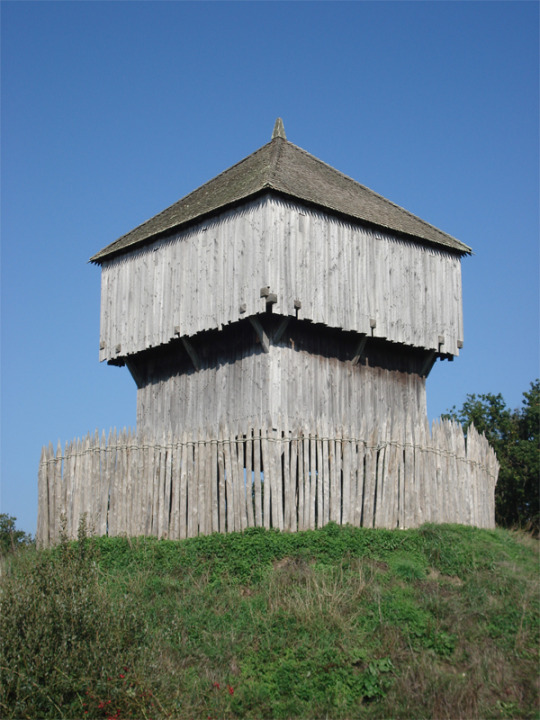

Hogwarts, when founded, probably looked like this combination of buildings and not what we imagine as a castle.
with the Chamber of Secrets as a basement. It's canon that a Gaunt later added the pipe entrance from the bathroom, so it's original entrance lay elsewhere.
Note that this means it wasn't the founders who but the Common Rooms, Room of Requirement, or the moving staircases and that the in-universe history books are wrong.
Since Hogsmeade was founded by Hengist of Woodcroft who was a student of Helga Hufflepuff when she was alive, the village was probably founded in the century following the school's founding.
1000s-1100s
Here we get the Norman Conquest of England, and while Scotland wasn't Norman, the culture in Scotland was influenced by the changes down south. Specifically, castle architecture is something they copied from the Normans.
The reason I mentioned earlier the muggle Witengamot might've not been aware of the wizarding community is because we know William brought with him wizards in his army, like the Malfoys:
Like many other progenitors of noble English families, the wizard Armand Malfoy arrived in Britain with William the Conqueror as part of the invading Norman army. Having rendered unknown, shady (and almost certainly magical) services to King William I, Malfoy was given a prime piece of land in Wiltshire, seized from local landowners, upon which his descendants have lived for ten consecutive centuries.
(Pottermore)
But many other pureblood wizard family names we can date back to the Norman invasion. Such as: Lestrange, Peverell, Wealey, Gaunt, etc. So, it's somewhat implied William won England with the help of wizards that the local Anglo-Saxon English didn't have fighting with them.
Due to these Norman wizards clearly getting positions of influence in the wizarding community (talked a bit more about this here[]), it's likely they or even William himself wanted to improve Hogwarts to keep the wizardibg population onside.
So, around the later 1000s or early 1100 Hogwarts would've looked something like this:



So, basically, the same structure as before, but the keep (where the Great Hall is, is built from stone. The Great Hall (AKA the most defensible place in the castle everyone fell back to in the Battle of Hogwarts) was the first built.
As for the inside:


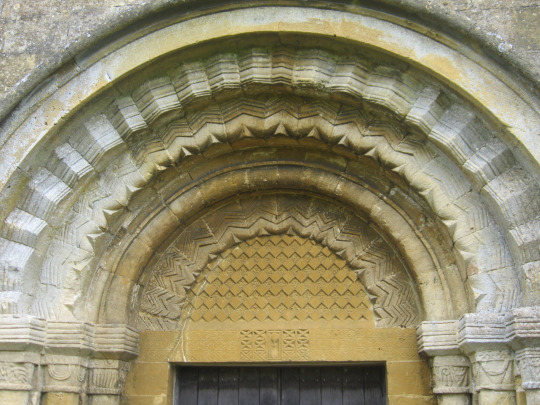
We have geometric details on the columns and archways (which are round, it's not yet the pointed gothic arches we all know and love). The walls would all be painted white and then colorful and vibrant colors over it (somewhat visible in the picture on the left).
1200s-1300s
Throughout the next two centuries, more and more wings would be added to the castle. Many of the classrooms and dorms that were outside the keep in the outer buildings moved to these new wings inside the main stone castle. The outer walls & fortifications would also be improved and extended from the former ones and a proper gatehouse would likely be built:
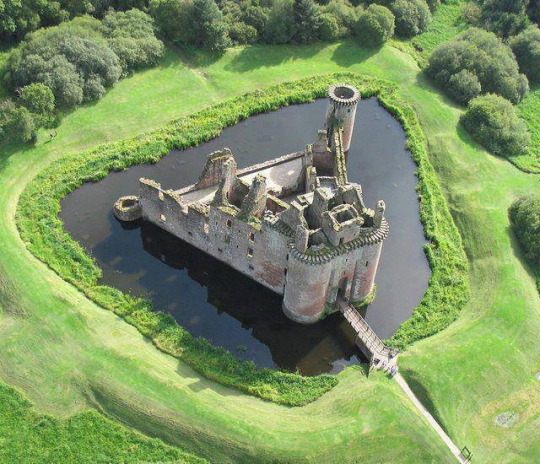

And a few churches, since they tended to be more decorated on the outside and I want to explain this is when gothic architecture was a thing and that most of the styles we recognize for castles are from this period:



This is when the Room of Requirement, the moving staircases, the towers (the Astronomy Tower, the Headmaster's Tower, and perhaps the Owlery), and the various common rooms would be built.
(Note the castle on the left would've likely had a whitewash on all of the exterior back in the day)
At this point, the Great Hall, and the quad if we think of the typical Hogwarts castle would be built:

(Image from Hogwarts Legacy)
There would be no transfiguration courtyard area yet and no clocktower yet as they are likely later additions.
I'd also note the inside of the castle, would look something like this at this point:
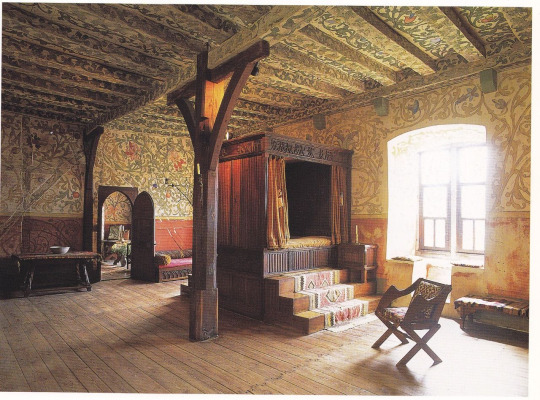


The walls would be painted and colorful and vibrant. You might also see wall hangings like we see in the Gryffindor Common room in the movies, that's actually accurate (the wall tapestry/curtain things, not the furniture, the furniture is 17th and 18th century) except the stone would likely not be bear stone and instead have a whitewash over it and tapestries over the whitewashed stone. Bear stone wasn't an all that common look in this era unless they used pretty stones that were meant to be shown off (which was expensive, hence rare).
1500s-1600s
This period is still building in a style called Gothic (12th to 16th century), but we're adding more intricate detail, and the style for furniture changes quite drastically (because we've entered the Tudor area). I believe that around the 1500s and the 1600s, more wings were added, like the clocktower, the transfiguration courtyard, and the viaduct (a bridge was probably there before, but I think it was rebuilt with the new building):

The style of buildings we're looking at now would have this sort of exterior:
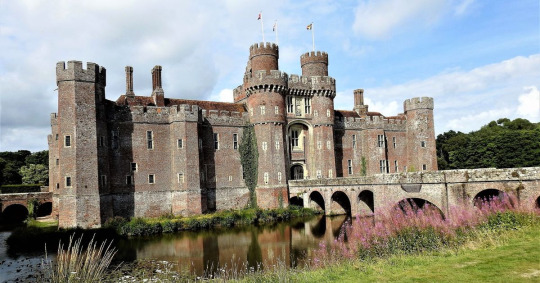
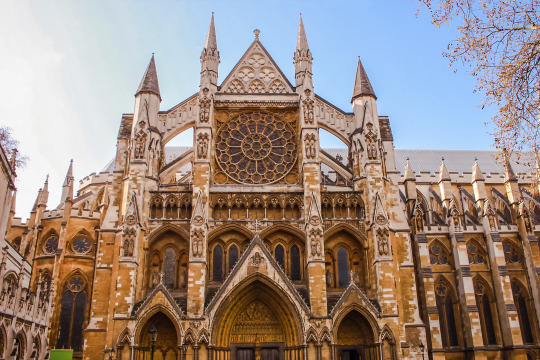

(Note the house on the left and castle on the white would've likely had a whitewash on all of the exterior back in the day)
And this is the interior we're talking about:
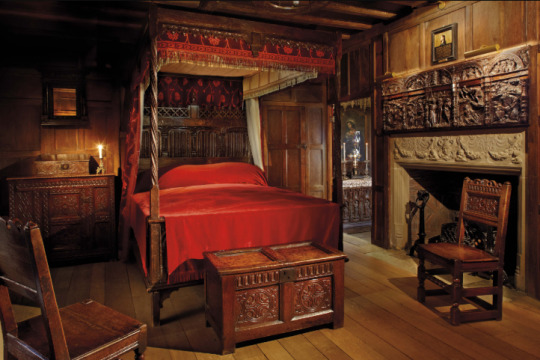
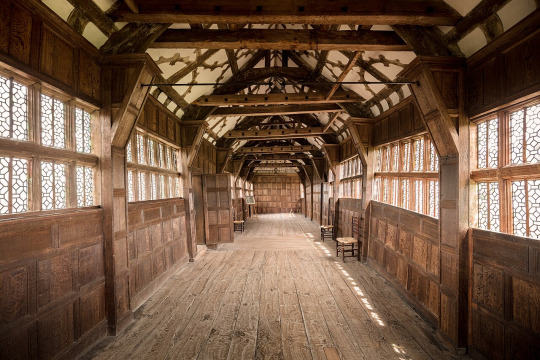
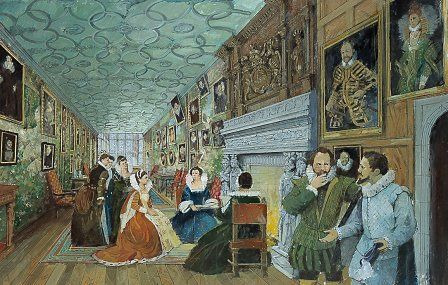
Also, up until this point, greenhouses weren't really a thing (at least not the glasshouse variety). I assume there was an Herbology Garden or that perhaps a Vegetable Patch Harry mentions exists next to the greenhouses and served as the place where they grew plants because glasshouses like we think of when we read the word "greenhouse" were only started being built in England late in the 16th century. So the Greenhouses are likely a 17th-century addition since the wizards probably adopted them a little later than the muggles.
1700s
This is when indoor plumbing was introduced to Hogwarts and the entrance to the Chamber of Secrets was changed:
When first created, the Chamber was accessed through a concealed trapdoor and a series of magical tunnels. However, when Hogwarts’ plumbing became more elaborate in the eighteenth century (this was a rare instance of wizards copying Muggles, because hitherto they simply relieved themselves wherever they stood, and vanished the evidence), the entrance to the Chamber was threatened, being located on the site of a proposed bathroom. The presence in school at the time of a student called Corvinus Gaunt – direct descendant of Slytherin, and antecedent of Tom Riddle – explains how the simple trapdoor was secretly protected, so that those who knew how could still access the entrance to the Chamber even after newfangled plumbing had been placed on top of it.
(Pottermore)
1800s
Now, back to what I mentioned in the opening paragraph about Victorian castle reconstruction. So, during the Victorian era, many rich people bought castles to restore and preserve them. Victorians in England were kinda obsessed with the Medieval period (and Ancient Egypt, but we're not talking about that right now) so they wanted to be able to walk around castles, and they had a lot of castles in the UK that fell into disrepair and just stood there empty. The thing is, the Victorian people who restored castles had no idea what Medieval castles actually looked like in the Medieval period. So all the castles you see with this sort of interior (which are most reconstructed castles, btw):
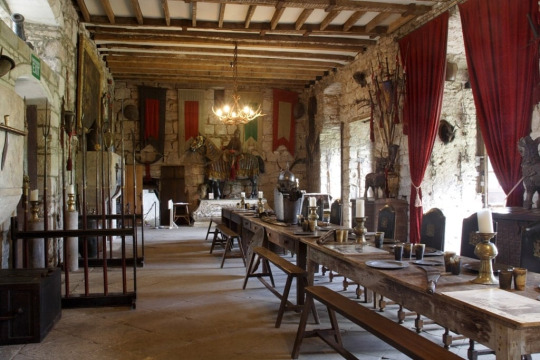
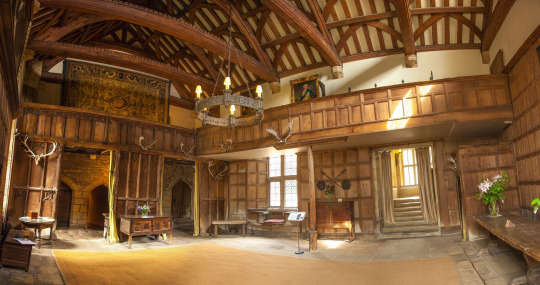
That's a Victorian reconstruction. They built how they imagined medieval castles looked like according to their own tastes and aesthetics and what they saw from more recent Todur castles, not how medieval castles actually looked like.
That being said, Hogwarts was continuously used throughout all these years, so I imagine some of these Victorian elements would make their way in, but not to the same level as these reconstructions.
Basically, different locations in the castle would look different depending on when they were built. Most furniture is likely to have been replaced more recently and would at most date back to the 1500s. So, we'll see a lot of dark wood furniture that isn't painted the way they would've painted furniture in the medieval period.
I'd also expect that some of the older walls/ceilings are still painted very vibrantly (which fits with the wizard's sense of style overall).
Basically, I think the Hogwarts we experienced in the books wasn't built in one year as a monolith by the founders. It was added to over time. Rooms that look older Medieval, and ones that look like a Tudor addition would all exist within the same castle. Areas in the older sections would have 18th-century wooden paneling because reconstruction was needed. I personally think that's the right way to go about designing Hogwarts since most castles in Britain are like that (and in the rest of Europe).
Castles changed and grew according to the needs of whoever lived there at the time and the technology available. And since, well, at some point castles weren't needed as fortified structures anymore, they lost fortifications for aesthetics. We have no surviving castles that actually look the way they did back when they were built. All the preserved ones had wings added, walls paneled with wood, and the windows replaced. And in many of them, you can actually see the patchwork in the bricks, the window style changing from one window to the next across a single wall. I think that's part of what makes castles gorgeous and it always made sense to me Hogwarts was like that too.
#harry potter#hp#hp meta#hollowedtheory#harry potter meta#wizarding world#hogwarts#hogwarts school of witchcraft and wizardry#hogwarts castle#wizarding world of harry potter#hollowedheadcanon#hp headcanon#hollowed hp redesign#historical context#wizarding history
85 notes
·
View notes
Text









COLORS, SYMBOLISM AND HISTORICAL PARALLELS BLUE • In the 12th century the Roman Catholic Church dictated that painters in Italy (and the rest of Europe consequently) to paint the Virgin Mary with blue, which became associated with holiness, humility and virtue. • Paintings of the mythical King Arthur began to show him dressed in blue. The coat of arms of the kings of France became an azure or light blue shield, sprinkled with golden fleur-de-lis or lilies. Blue had come from obscurity to become the royal colour. • Cobalt was originally discovered in the 8th and 9th centuries, where it was used to decorate ceramics and jewelry. • Cerulean comes from the Latin word caeruleus, which means “dark blue” and is most likely derived from caelum, the Latin word for “sky.”
#hotd#house of the dragon#house targaryen#the dance of the dragons#pre asoiaf#asoif/got#rhaenyra targaryen#daemon x rhaenyra#medieval history#history#historical context#queen alicent#alicent hightower#team black#fantasy costume#medieval costume#fantasy#daemon targaryen#daemyra#helaena targaryen#laena velaryon
69 notes
·
View notes
Text
andor season 1 is very very good but esp with having read quite a bit since about how police states and internal security has worked in real life ….. I think it missed so many fucking opportunities and issues with the ISB. They’re too clean. Too centralized. Too organized. They actually know what’s going on. They aren’t bloated under the weight of spying on literally (according to canon) trillions of people, or swamped by the physical burden of endless tapped phone conversations and stolen letters and informants. They don’t bug apartments or tap phones, and they don’t have a massive network of informants who turn in their neighbors and friends and coworkers on a regular basis - Timm is shown to be a one off outlier, and mon mothma is afraid of her driver listening in on her, not that every call she’s making is being tapped and every room in her house is bugged even though she’s a high level diplomat living outside of her home planet. And somehow they all have the focus to send one of a round table higher level officials to deal with a relatively minor scuff up in Ferrix?
What bothers me is that they’re ironically both more focused and competent and less brutal than almost all of their real 1970’s counterparts in say both the right wing southern cone and Iberian dictatorships and the communist eastern bloc were. In those cases a lot of brutality was carried out because the spying organization could due to sheer size be so fucking dysfunctional, because totalitarianism as a whole is terrifyingly dysfunctional, because the people spying knew everything and nothing and were often disoriented by their own actions and infighting.
They were full of bizarre scenarios like how repression of education and distrust of intellectuals - in all above cases - often lead to really uneducated entry level lackies trying to keep tabs on the evil doings of university professors and coming away with stuff like the fact dosteyevski must be a local dissident. But one of the big things they really, really did is completely violate people’s sense of the divide between public and private so that their victims felt terrified in their own homes, and the “I just want to go home” show needed to more with that.
anyway it’s odd to see dedra meero be one of the top council of 12 when she’s also a low enough agent to be tracking missing equipment and torturing individual suspects. I think this show would be so much better if she was a mid level pencil pusher in a profoundly chaotic bureaucratic workspace full of filing cabinets and spilled coffee where everyone feels only one step away from facing relegation or being spied on themselves. Give her the need for career advancement, yes, please, but give everyone the deep rooted paranoia that they too might be considered rebel spies and let the show watch them eat each other
33 notes
·
View notes
Text
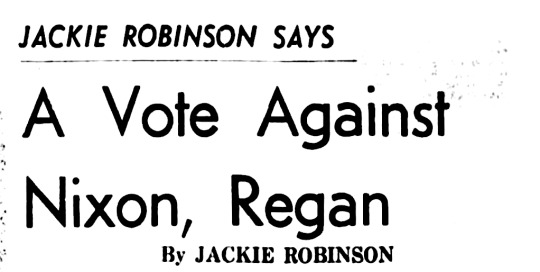

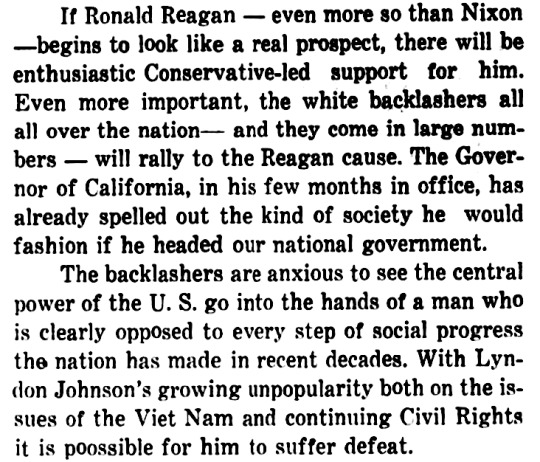


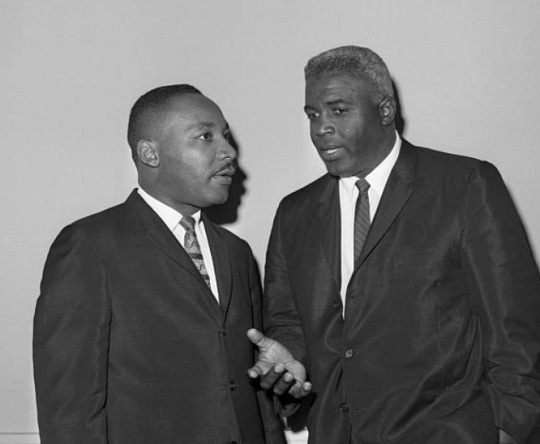
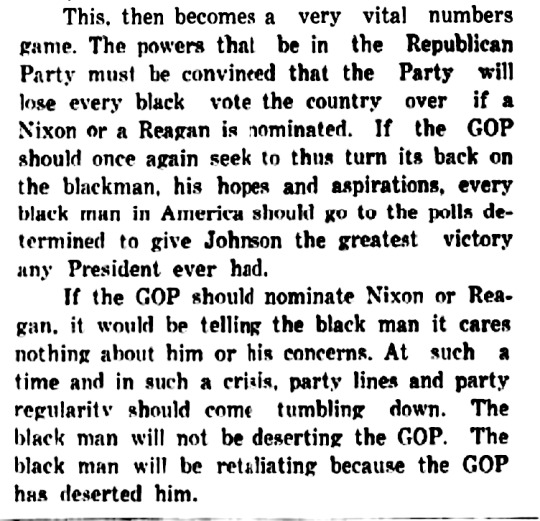
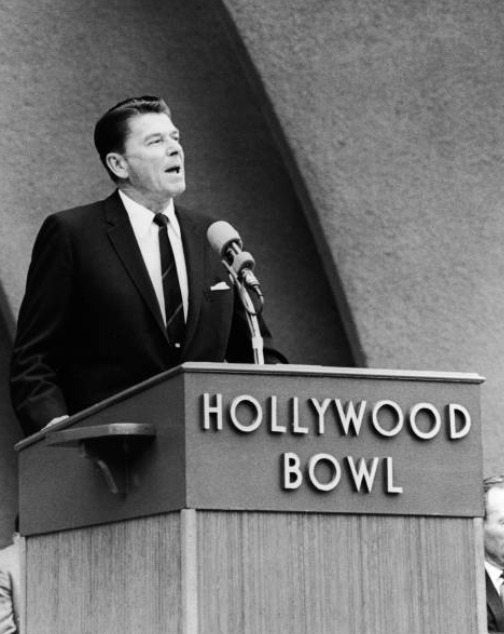
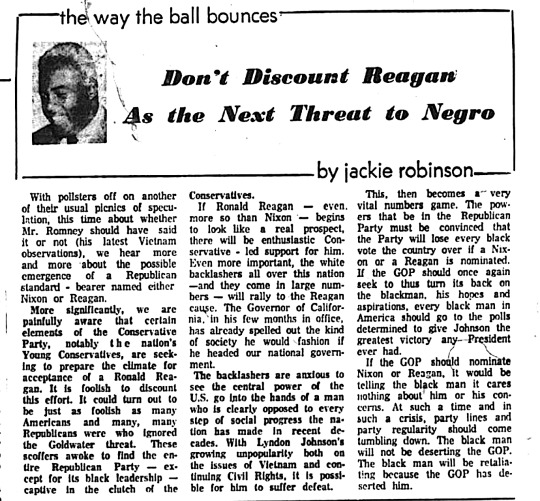
In an editorial published in the Pittsburgh Courier on September 30, 1967, baseball legend Jackie Robinson warned that Ronald Reagan would roll back all the gains made by the Civil Rights Movement, from the Voting Rights Act to Affirmative Action.
1K notes
·
View notes
Text
I promised to talk about Robespierre


Okay, keeping up with these entries this week will be hard. But let's see what I can do.
But yes, I was asked by several people about Robespierre, given that he has this small cameo in Castlevania Nocturne. And since most people do not know much about him outside of "he was kinda important in the French Revolution" and "he ended up being beheaded", I guess I should talk a bit a more.
One thing that might surprise you: Robespierre was not part of the people who kicked the Revolution off, though he joined fairly early on.
Robespierre was the first kid of his very young parents. He definitely was conceived in wedlock, though his parents managed to tie the bow before he was born. After his birth, three more children were born, before his mother died in the stillbirth of the fifth child. His father soon abandoned the four living kids with his grandparents and basically disappeared from Robespierres life, though eventually he was raised by his aunt.
He was good in school and went to study law. During his education he was obsessed with the Roman Republic, not the Roman Empire. So yes, he thought about the Romans at least once per day, but not the Empire. He gratuated law school with honors and got appointed as a prosecutor, but quit that rather quickly. Because of his distaste for the death penelty. Yes, this will be ironic eventually.
The started writing essays and pamphlets as the Revolution started to be brewing, and when what would become the first Assembly was being voted for, he ended up to become the Deputy of Flanders and went to Paris.
He quickly joined the Jacobin Club, which was not really a party, but a very left-wing oriented political Club in Paris, who had quite a lot of deputies being part of it. Robespierre cared a lot about the idea that "all men were equal" before the law. Even among the Jacobins he was pretty much an extremist in this regard, given that he proposed both the abolition of slavery and sufferage for both Black people and later even for women. While he certainly held some believes that you would absolutely call out as racist and misogynic today, mainly in regards to their mental capabilities (he also wrote texts on how women were more emotional, though he noted that for this they were more moral).
During his first two years in the Assembly, he coined the famous motto Liberté, égalité, fraternité.
For the first two years of him being in the Assembly, this was mostly it - and then Louis XVI fled from Paris and was eventually obviously caught before he could leave France. Up until this point they had decided that France was supposed to be a Constitutional Monarchy, but now it was fairly clear that this did not quite work out. And it riled people up on both sides - both Royalists who wanted to return to the old regime, and Republicans started riots in the streets, and then people got shot.
Robespierre to this point had lived in a better part of town, but left there to move in with a craftsman and his family.
At this point Robespierre started to get the reputation of being "the incorruptible", as he was just someone who stood firmly and constantly by his own believes as he was speaking in the Assembly.
Due to his own decision (he believed that not the same people should stay in the Assembly all the time), he did not become re-elected later in 1791. But when it became clear that the new Assembly wanted to declare war on Austria before Austria could declare war on them (something that might or might not have happened - it was kinda both sides goin "I dare you!" - "Ha, I double dare you!"), he started to speak up again, specifically against war.
He rightfully pre-dicted that starting a way would help the counter revolution to gain more power. (He specifically feared that some general could use the war to make himself into a new king - something he was right on the money with, given that this lead eventually to Napoleon, though Robespierre at the time was actually thinking of Lafayette.)
When war was still declared, Robespierre started to put in work that the normal public should be armed. Both so that they would be trained with weapons if they needed to be drafted, but also so that if there was a coup within the country they could fight back. At this time he also became quite outspoken about his mistrust over the local police in Paris. (Very based.)
This started the Paris Commune, a short-lived anarchist commune within Paris.
Now, with the war starting, there were so many rumors going around about people being traitors to the French people, and some people were outright caught betraying France. Robespierre proposed that there should be a legal institution to deal with traitors specifically. He was appointed to it pretty soon.
Within the year, he also joined the National Convention, as France declared herself a Republic.
And one of the first things this National Convention voted on, was executing Louis.
Again, I will remind you: Robespierre hated the death penelty. However, he became more and more convinced that there was no other way to deal with the king, as there were of course other royalists who would probably try to hoist up the king once more. Hence, he ended up not only voting in favor of executing Louis, but also convinced others to do so.
However, war will lead to certain things - as we know in our modern day quite well. Most notably the food prices were rising, which lead to armed insurrections on the streets of Paris, that Robespierre supported. After all, he supported the people. And when this turned into a whole argument within the Convention, he started to become more and more convinced, that within the Convention there were two fractions: Jacobins and traitors to the French Republic.
And this situation escalated. Over the late summer and autumn 1793, and this lead to what most people know about the French Revolution: The Reign of Terror.
Long story short: Everyone accused everyone else of being a traitor and foreign spy and people got sentenced, and within a day beheaded.
Again: Robespierre did not like the death penelty, but by this point he had reasoned himself into the believe that this was the only way to deal with all those people rebelling against the republic. As such, he even signed the Death Warrants of some of his own friends.
And for a short bit it seemed to work as a method of pushing down the counter-revolution, though it became very clear that one of the biggest problems were the conflicts with church, which lead him and his fellow people in the Convention try to make their own theist church, that was however divorced from Christianity.
It did not really work.
And then... Well, things became really bad. There were a couple of assassination attempts, even more people got beheaded. Again, among this there were even close friends of Robespierre's, which turned public opinion against him. And eventually he got shot (though not fatally) by political opponents, and then within the day struck with the death penelty. He died not even full day after his arrest.
I think he is actually a really interesting figure in this context. Because, if you read his writing, he seemed to have been quite a decent, moral man, with a lot of opinions that were a lot more progressive than even many of the other revolutionaries. Yet, if it was just the power going to his head, or just the general paranoia that came out of the climate in France at the time, in the end he pretty much betrayed most of his morals in a desperate attempt to keep the Revolution going. And while I will still maintain that the Reign of Terror was not the main reason that the Revolution somewhat failed (it did not fail completely of course, given that even after the end of it, the convention kept going), it was a core reason of it.
#castlevania#castlevania netflix#castlevania nocturne#french revolution#history#historical context#maximilien robespierre#robespierre#reign of terror
62 notes
·
View notes
Text
Hugo had a classmate named Joly. The boy was from a rich and respectable family, but he started gambling, spent his family fortune, and ended up in prison for forgery. Thanks to Hugo’s intervention, his sentence was shortened to four years. In the mid-1840s, a white-haired man in ragged clothes approached Hugo, and he hardly recognized Joly. He gave him money once, twice… and as it continued for some time, Hugo decided he had enough.
As a result, he used Joly’s story for several purposes. His life story became a kind of antithesis to Valjean’s: a tale of moral degradation and loss of money was reversed into a story of moral reform and upward social mobility. Joly, like Valjean, broke his parole and instead of the ascribed place of residence, he arrived in Paris where he met Hugo. Finally, his name was given to one of Les Amis.
128 notes
·
View notes
Text
Jonathan Harker praises the bottle of Tokaji wine he was served at Dracula's Castle on his first night there.
Tokaji is one of the oldest dessert wines. Sweet, intense in flavor, and prestigious. Produced in Tokay, Hungary since the 16th century. Most often paired with spicy and hot dishes.
Apparently Jonathan enjoys sweet, intense wines.
Erik in The Phantom Of The Opera novel offers Tokaji to Christine Daaé during her first visit in his lair.
Mephistopheles in Goethe's Faust serves it to the young lovestruck Siébel. (Siébel: 'No wine for me can ever be too sweet.' Mephistopheles: 'My best Tokaji shall presently appear.')
In the 19th century it was used as a remedy for plague and anemia.
#in the 19th century it was used as a remedy for plague and anemia#dracula daily#jonathan harker#dracula#re: dracula#the phantom of the opera#faust#poto#wine#historical context
596 notes
·
View notes
Text
I know we've all moved on from Mina's Brief Foray into Misogyny in favour of Jonathan Is Back, Hooray! but
I do think it's interesting to read real contemporary women's views on the early women's rights movement, and honestly Bram Stoker's depiction of how Mina sees things isn't all that far off (i.e. he's not just writing her that way because he's a clueless man).
A while ago, I read the memoirs of Maud Allan, an Edwardian dancer who lived a truly fascinating and often tragic life; it's worth reading her whole Wikipedia page. Her memoirs, published 1908, are not particularly worth reading (they were primarily publicity material), but there is one section where she talks about her views on women's suffrage.
Maud Allan was a highly educated, often controversial figure, who danced topless but for some intricate jewellery. She made her own living, and was most likely a lesbian - so all in all, much like Mina, not someone you would think of as likely to be ambivalent on gender equality. Nonetheless, she argued:
Women should "influence rather than dictate"
Women should be educated; she did not believe there was any difference between male and female intelligence, only in the opportunities they received
The rightful destiny of every woman was to be a wife and mother [even though she was neither]
Women were swayed by emotion more than men, so shouldn't become lawyers
Women would be swayed by the looks and personality of a political candidate, not by his views
As a result, in most areas men and women should be equal - but not in terms of the franchise, or at least not yet.
(The whole chapter is here).
I find this fascinating because from a modern-day perspective, it's so obviously inconsistent and muddled, in particular the sense of gender equality as a kind of grab-bag where women should be equal in some areas but not others. But these were the honest views of an educated, independent woman, and I could imagine a real-world Mina having a similar set of views.
892 notes
·
View notes